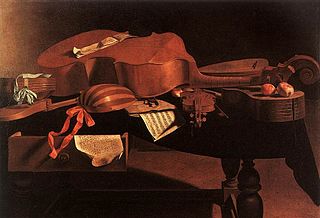This article needs additional citations for verification .(February 2008) |
A musical hoax (also musical forgery and musical mystification) is a piece of music composed by an individual who intentionally misattributes it to someone else. [1]
This article needs additional citations for verification .(February 2008) |
A musical hoax (also musical forgery and musical mystification) is a piece of music composed by an individual who intentionally misattributes it to someone else. [1]

A chaconne is a type of musical composition often used as a vehicle for variation on a repeated short harmonic progression, often involving a fairly short repetitive bass-line which offers a compositional outline for variation, decoration, figuration and melodic invention. In this it closely resembles the passacaglia. It originates and was particularly popular in the Baroque era; a large number of Chaconnes exist from the 17th and 18th centuries.

The passacaglia is a musical form that originated in early seventeenth-century Spain and is still used today by composers. It is usually of a serious character and is typically based on a bass-ostinato and written in triple metre.

Friedrich "Fritz" Kreisler was an Austrian-born American violinist and composer. One of the most noted violin masters of his day, and regarded as one of the greatest violinists of all time, he was known for his sweet tone and expressive phrasing. Like many great violinists of his generation, he produced a characteristic sound which was immediately recognizable as his own. Although it derived in many respects from the Franco-Belgian school, his style is nonetheless reminiscent of the gemütlich (cozy) lifestyle of pre-war Vienna.
This is a list of notable events in music that took place in the year 1735.
This is a list of notable events in music that took place in the year 1732.
This is a list of notable events in music that took place in the year 1731.
The year 1730 in music involved some significant events.
The year 1726 in music involved some significant events.
The year 1721 in music involved some significant events.
The year 1713 in music involved some significant events.
The year 1711 in music involved some significant events.
The year 1708 in music involved some significant musical events and new works.

Gaspar Cassadó i Moreu was a Spanish cellist and composer of the early 20th century.

Gaetano Pugnani was an Italian composer and violinist.

Henri-Gustave Casadesus was a violist, viola d'amore player, composer, and music publisher.

Christophe Rousset is a French harpsichordist and conductor, who specializes in the performance of Baroque music on period instruments. He is also a musicologist, particularly of opera and European music of the 17th and 18th centuries and is the founder of the French music ensemble Les Talens Lyriques.
The Adélaïde Concerto is the nickname of a violin concerto in D major attributed to Wolfgang Amadeus Mozart and given the catalogue number K. Anh. 294a in the third edition of the standard Köchel catalogue of Mozart's works. Unknown until the 20th century, this concerto was later discovered to be a spurious work by Marius Casadesus. It was given a new number in the sixth edition of the Köchel catalogue, K. Anh.C 14.05, as part of the Anhang C designated for spurious or doubtful works which have been attributed to Mozart at some time.

Baroque music refers to the period or dominant style of Western classical music composed from about 1600 to 1750. The Baroque style followed the Renaissance period, and was followed in turn by the Classical period after a short transition. The Baroque period is divided into three major phases: early, middle, and late. Overlapping in time, they are conventionally dated from 1580 to 1650, from 1630 to 1700, and from 1680 to 1750. Baroque music forms a major portion of the "classical music" canon, and is widely studied, performed, and listened to. The term "baroque" comes from the Portuguese word barroco, meaning "misshapen pearl". The works of Antonio Vivaldi, George Frideric Handel and Johann Sebastian Bach are considered the pinnacle of the Baroque period. Other key composers of the Baroque era include Claudio Monteverdi, Domenico Scarlatti, Alessandro Scarlatti, Alessandro Stradella, Tomaso Albinoni, Johann Pachelbel, Henry Purcell, Georg Philipp Telemann, Jean-Baptiste Lully, Jean-Philippe Rameau, Marc-Antoine Charpentier, Arcangelo Corelli, François Couperin, Johann Hermann Schein, Heinrich Schütz, Samuel Scheidt, Dieterich Buxtehude, Gaspar Sanz, José de Nebra, Antonio Soler, Carlos Seixas, Adam Jarzębski and others, with Giovanni Battista Pergolesi being the most prominent Baroque composer of sacred music.